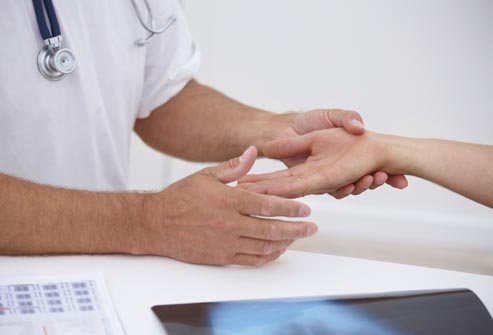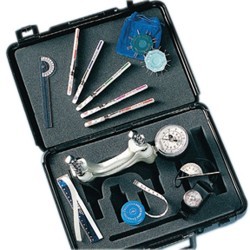 8th Oct 2018
8th Oct 2018
The Best Practices for Performing a Complete Hand Evaluation
A hand evaluation is useful for treating patients who suffer from chronic conditions like Rheumatoid arthritis and ligament injuries like skier’s thumb. What’s more, a hand evaluation can be beneficial when training with athletes looking to boost their athletic performance or in the course of performing a strength test as part of a job performance or applicant application.
To perform a full hand evaluation there are five areas to consider:
- 1.Tactile & Sensory Function
- 2.Strength
- 3.Range of Motion
- 4.Swelling & Edema
- 5.Nerve Impairment
In order to perform a full-scale hand evaluation, the following tools are essential to get the most accurate measurements of strength, range of motion and sensation:
- Hydraulic hand dynamometer
- Mechanical pinch gauge
- Small joint goniometer
- 180-degree 6-inch plastic goniometer
- Flexible tape measure
- Finger circumference gauge
- Touch-Test monofilaments
- Discrim-a-Gon
Each of these tools provide valuable measurements that are pieces of the puzzle that when put together form a complete picture of a patient’s hand strength and dexterity. However, some strength testing tools measure overall strength and/or specific muscle groups. Certain measurement tools, like a handheld dynamometer, are similar to hand strength testing tools, but are used for manual muscle testing to get a sense of overall strength.
So, what is the difference between a hand-held dynamometer and a grip strength dynamometer?
A handheld dynamometer is held in the hand of the examiner and applied against the individual being tested. Handheld dynamometers can be used in a variety of different muscle tests that can measure the patient's muscle strength for both upper and lower extremities. Common muscle testing procedures include flexion, extension, and abduction of both the shoulders and hips.
However, when looking to perform a hand evaluation, a hand grip dynamometer is held in the hand of the person being tested and is used to measure only their grip strength. The uses for grip strength dynamometers are more limited and specific than your average handheld dynamometer so it is important to make sure you know what muscle testing procedures you will be performing before you buy either device.
Muscle testing using a hand dynamometer varies in many ways but each testing procedure has one thing in common - Each test is performed in a Gravity Eliminated pose. Gravity eliminated means that you are measuring muscle strength while the patient is not being influenced by gravity. The patient exerts force on the device sitting or Supine position in order to remove gravity's influence on the results. These results can then be compared to established values for strength based on gender and/or age. Based on these findings, in rehabilitation, appropriate treatment protocols and training regimens can be geared towards improvement. When evaluating job applicants or evaluations, results can be used to determine the ability to successfully complete specific job tasks.
How to Perform a Full Hand Evaluation
One of the easiest ways to perform a full hand evaluation is with an evaluation kit. Jamar offers a complete 8-piece hand evaluation kit complete with the tools we’ve listed above. Let’s look at what role each evaluation tool plays in a complete evaluation.
Hydraulic hand dynamometer: Jamar’s hydraulic handheld dynamometer provides valuable grip strength readings. The Jamar dynamometer features an adjustable 5-position handle to accommodate patients with various hand sizes and strengths. With a maximum strength indicator that remains after each reading until reset, practitioners can easily chart their results.
Mechanical pinch gauge: From picking up a pen to using a knife to cut food, pinch strength is valuable in multiple daily tasks. When using a pinch gauge, it’s important to pick a tool that provides accurate and repeatable pinch strength readings (tip, key and palmer). There is a pinch gauge included in the Jamar Hand evaluation kit or Baseline offers a pinch gauge that comes with a handy carrying case.
Small Joint Goniometer: Another piece of the puzzle for a hand evaluation is range of motion. When range of motion is inhibited in the hand, it can negatively impact a patient’s ability to perform daily activities or job tasks. A small joint goniometer measures range-of-motion of finger joints (metacarpophalangeal and interphalangeal) and can be used on other small joints including toes.
180-degree 6-inch plastic goniometer: For even greater accuracy measuring range of motion, a 180-degree goniometer can be used to measure flexion, extension and hyper-extension. This provides practitioners the ability to measure 110-degree flexion through 40-degree hyper-extension in 5-degree increments.
Flexible Tape Measure: A tape measure is always handy for evaluations of any kind. When used for hand evaluations, a tape measure is great for measuring localized edema.
Finger circumference gauge: Another great tool that can be used to measure localized edema is a finger circumference gauge, which can be used to accurate identify swelling in particular digits.
Touch-Test Monofilaments: Whether a patient has suffered a hand injury or suffers from a chronic condition, there can be sensory or nerve impairment. To identify the level of impairment, a touch-test monofilament is used to accurately measure skin sensitivity and determine peripheral nerve involvement.
Discrim-a-Gon: The Discrim-a-Gon is useful for further testing on patients who have suffered a nerve injury and can be useful for establishing a baseline after a nerve injury, like a compression and tracking progress with nerve re-education. What makes the Discrim-a-Gon useful is it measures innervation density of any surface area, not just the fingertip.
While these tools can be purchased as part of a kit, like the Jamar 3-piece or 8-piece Hand Evaluation Kit, they can also be purchased individually depending on your clinic’s hand evaluation needs.
The Best Individual Hand Evaluation Tools
Tactile & Sensory: In order to fully measure tactile ability or impairment, the Baseline Tactile Semmes-Weinstein Sensory Monofilament Hand Set of 5 comes complete with the following filament sizes: 2.83, 3.61, 4.31, 4.56, 6.65 to provide a complete tactile evaluation.
Strength:
Grip: The Baseline 200-lb capacity HD hydraulic hand dynamometer is a great choice for clinics only looking to accurately measure grip strength.
Pinch: The Baseline 60 lb. Mechanical Pinch Gauge is a great choice for clinics looking to measure tip, key and palmer pinch strength in patients with varying degrees of strengths and dysfunction.
Range of Motion: The JTech Commander Echo Goniometer provides precision measurement results for range of motion (including hypertension) in both large extremity joints and small finger joints. The JTech Commander Echo Goniometer is a great choice for clinics that need to measure larger extremities. The JTech Goniometer can measure large extremity alignment with the use of extensions.
Baseline offers a 6-piece Goniometer set that provides full range of motion testing at an economical price, without sacrificing the quality of measurement results.
Swelling: The Baseline Circumference Tape measure measures 72 inches and can be used to easily evaluate swelling of a single joint or digit.
Nerve Injury: The Baseline Discrim-A-Gon 2-Point Discriminator is easy to use and lightweight. The Discrim-A-Gon measures a different range of 8 labeled fixed 2-point intervals that range from 1 mm to 25 mm to accurately pinpoint deficits as a result of nerve injury.
Whether looking to perform full hand evaluations with the use of a full kit or need individual testing tools, it’s important to understand what role each device plays in completing a full picture of hand strength and function.
Contact us today!
We can help your practice find the perfect hand evaluation kit to help your practitioners treat all issues or injuries concerning the hands. Contact us today and we’ll answer any questions you may have about the benefits of using each device! Call us today at 1-801-770-3328 for more information.







